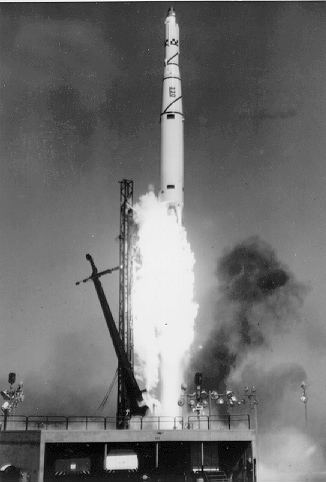Mission type Optical reconnaissance Harvard designation 1961 Alpha Epsilon 1 Rocket Thor DM-21 Agena-B 330 Inclination 82.5° Launch mass 1,150 kg Bus RM-81 Agena | Operator US Air Force/NRO Spacecraft type KH-3 Corona''' Launch site Vandenberg LC-75-1-1 Period 1.6 hours Launch date 5 November 1961 Manufacturer Lockheed Corporation | |
 | ||
Similar LOFTI‑1, Transit 3B, Discoverer 18 | ||
Discoverer 34, also known as Corona 9027, was an American optical reconnaissance satellite which was launched in 1961. It was a KH-3 Corona''' satellite, based on an Agena-B.
The launch of Discoverer 34 occurred at 20:00 UTC on 5 November 1961. A Thor DM-21 Agena-B rocket was used, flying from Launch Complex 75-1-1 at the Vandenberg Air Force Base. Although the satellite achieved orbit, and was assigned the Harvard designation 1961 Alpha Epsilon 1, the launch was unsuccessful. An anomalous angle taken during ascent resulted in the spacecraft being placed into an unusable orbit. It was the second consecutive KH-3 launch failure; the previous mission, Discoverer 33, had failed to achieve orbit due to a separation failure.
Discoverer 34 was launched into a low Earth orbit, with a perigee of 225 kilometres (140 mi), an apogee of 970 kilometres (600 mi), 82.5 degrees of inclination, and a period of 96.6 minutes. The satellite had a mass of 1,150 kilograms (2,540 lb), and was equipped with a panoramic camera with a focal length of 61 centimetres (24 in), which had a maximum resolution of 7.6 metres (25 ft). Images were to have been recorded onto 70-millimeter (2.8 in) film, and returned in a Satellite Recovery Vehicle. The Satellite Recovery Vehicle to be used by Discoverer 34 was SRV-553. Due to the launch failure, and a problem with a gas valve on the spacecraft, recovery of the SRV was not attempted. Discoverer 34 decayed from orbit on 7 December 1962.
